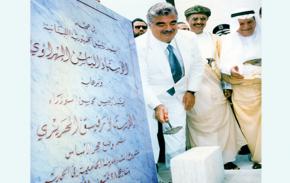إن اسهامات رفيق الحريري الخيرية والإنمائية لا تحصى، وأبرزها المساعدات المتعددة الأوجه لستة وثلاثين ألف طالب جامعي في جامعات لبنان وخارجه
أنت هنا
FRAMEWORK AND MODELS FOR THE PROVISION OF REAL-TIME DRIVER INFORMATION
التبويبات الأساسية
Issam A. KAYSI
|
Univ. |
Massachusetts Institute of Technology |
Spec. |
Civil Engineering/ Transportation systems |
Dip. |
Year |
# Pages |
|
Ph.D. |
1992 |
218 |
More efficient utilization of existing urban road networks may be achieved through dynamic traffic management schemes. Such schemes are needed to alleviate the increasing level of traffic congestion and the detrimental effect it has on mobility, accessibility, and safety in urban areas. The provision of drivers with real‑time information that is responsive to emerging traffic conditions has the potential to reduce both recurrent and incident congestion. However, the level of benefits to be derived from such advanced driver information systems (ADIS) depends to a large degree on the quality of the guidance being provided. The possible occurrence of adverse impacts due to improved information is demonstrated in this dissertation.
In order to insure the effectiveness of real‑time driver information systems, there is a need for an ADIS implementation framework that is based on a dynamic network modeling approach capable of assessing accurately network performance and forecasting traffic conditions that may exist in the near future. A framework that would satisfy these requirements is adopted in this dissertation consisting of a surveillance system which collects relevant traffic data, a congestion prediction module which provides the guidance system with congestion information, and a control and routing module which determines the guidance advice. The major principles embodied in this framework are:
Principle 1: Routing information should be based on projected traffic conditions.
Principle 2: There exists a need for an advanced COP module that makes use of current traffic conditions, predicted demand levels, guidance being provided, and anticipated driver response to guidance in making its predictions of future congestion in the network. The use of a dynamic traffic assignment, (DTA) model is suggested in order to provide such a congestion prediction capability.
Principle 3: Consistency has to be maintained between the guidance being provided to drivers and the predicted traffic conditions.
A framework that is bsed on the above principles has the potential to minimize the overall effect of congestion, generate useful and valid guidance, improve travel time reliability, and reduce the potential adverse impacts of improved information.
The modelling needs of the constituent elements of the framework are analyzed, with emphasis being placed on the dynamic network performance and driver behavior modelling aspects of the DTA that is suggested for congestion prediction. Methods of obtaining the O‑D predictions required by the DTA are also discussed. It is concluded that the state of the art in these areas is not yet prepared to support ADIS functions and that significant research is still required.
In this dissertation we also analyze the value of the proposed framework vis‑a‑vis other information provision scenarios and under various conditions using simulation. The scenarios that were considered include guidance based on last reported travel times, instantaneous travel times, and travel times that are predicted using a DTA. We present the results of a case study that was used to test the principles embodied in the proposed framework. The case study also analyzed the impact on guidance effectiveness of various parameters associated with congestion prediction, control as routing, and well as system demand and supply characteristics.










